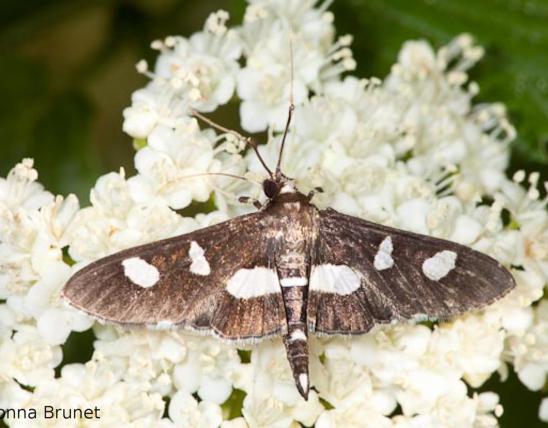
The grapevine epimenis flies during daytime and would seem too colorful to be a moth, but a moth it is. A member of the noctuid family, its many drab, grayish relatives include dagger, owlet, armyworm, cutworm, and earworm moths.
Adults are velvety black (both body and wings); the forewing has a large white patch, which usually has a notch on the inner margin; the hind wing has a large red to orange patch. In good light, the forewings show metallic highlights.
Larvae are similar to those of the beautiful wood-nymph (Eudryas grata): they are humped at the rear and are whitish with many thin black bands around the body (you could say they look zebra striped). The grapevine epimenis, however, has fewer black stripes per segment and (instead of having a number of additional, orange bands at intervals along the body) has a rusty or reddish band on only one anal (hind) segment; also, the head plate, cervical plate (“neck,” just behind the head), and anal plate (hump just before the hind end) are rusty or reddish with black spots.
Learn more about noctuid moths on their family page.
Similar species: Given its limited, springtime emergence and distinctive coloration and habits, this is a fairly easy moth to identify. The real trick is to recognize that it is a moth and not a butterfly! Among other differences, butterflies have club-tipped antennae and usually thinner bodies than moths.
The eight-spotted forester moth (Alypia octomaculata) is another fast-flying noctuid moth that flies by day and seems like a butterfly. Though it is generally similar to the grapevine epimenis, the coloration is still quite different. Its overall color is black, and each wing has two large white spots. It has orange on its legs but lacks any red or orange on the wings. Interestingly, both the forester and the epimenis use grapevines and Virginia creeper as caterpillar food plants.
Wingspan: approximately ¾–1 inch. Caterpillars reach about ¾ inch long before pupating.
Statewide; widespread in the eastern United States.
Habitat and Conservation
This is a day-flying woodland, woodland-border, and hedgerow moth with a fast, erratic flight. Adults fly only in the springtime. Look for this moth in April when wild plums are blooming. With a little practice, you can follow the sweet fragrance of the plum blossoms to the plum trees, then look for the visiting grapevine epimenis as well as butterflies, bees, and other pollinators.
Food
Like many insects, this species is named for its primary food plant. Caterpillars eat the foliage of grapes (Vitis spp.), including our several species of wild grapes, but also Virginia creeper (Parthenocissus quinquefolia), which is in the grape family.
Adults sustain themselves by drinking nectar from flowers. They are especially noted in Missouri for visiting the blossoms of wild plum (Prunus). They may also visit the flowers of hawthorns, swamp privet (Forestiera acuminata), and redbud — all species that have a spring bloom time matching their emergence as adults.
The adults also reportedly will take moisture and minerals from damp soil or sand near puddles, a behavior called “puddling,” which is usually associated with butterflies and not moths.
Status
Well-established breeding resident.
Life Cycle
There is only a single brood per year. The adults emerge from their pupal stage and fly in early spring, usually between late March in early May, with the peak in April, when wild plums are in bloom. The sexes are very similar. The females deposit eggs onto grapevines. The larvae eat the young foliage of grapevines and Virginia creepers; they create shelters for themselves by folding over the leaves and tying them closed with silk, or by attaching a few leaves together with silk. By late spring or early summer, the caterpillars have completed their growth and move into soft wood or other secure plant material to pupate. They overwinter in their pupal form.
Human Connections
The grapevine epimenis is one of many welcome signs that spring is finally here. It’s in the same category as pretty violets, birdsongs, and the blooming plums these moths love to visit.
This species does not seem to be a major pest of cultivated grapes. Missouri has plenty of wild grape vines for the caterpillars to consume, and the relatively short, early-season timing of the caterpillars allows ample time during the summer for grape vines to grow new leaves.
The way the common name is constructed, you might expect “epimenis” to be the genus name, not the species epithet. If the common name had followed the usual convention, we would call it the “grapevine psychomorpha.”
The genus name, Psychomorpha, means “butterfly-formed,” as psyche (in addition to meaning “mind” or “soul”) is also the ancient Greek word for “butterfly.” The species name, epimenis, perhaps refers to the crescent- or moon-shaped markings upon the wings.
Ecosystem Connections
Both the larvae and adults provide food for birds and other insect eaters. The caterpillars’ behavior of hiding in leaf shelters is a hint that they are an in-demand prey species. And in April, with many birds nesting and hungry for high-protein foods such as insects, the adult moths must also be a choice prey item. Their fast, erratic flight helps these day-fliers survive attacks by predators that hunt by sight.
Many insects with a bold black-and-red coloration are toxic or distasteful to predators, or else possess a venomous sting. Tiger moths, for example, often have black-and-red patterns, which advertises to potential predators that they are inedible. And many kinds of stinging wasps sport black-and-red patterns. But moths don’t sting, and the grapevine epimenis is apparently not toxic or distasteful to predators, so the bright colors may be a deceptive mimicry that helps the moth to survive long enough to reproduce.
Another hypothesis for the bold black-and-white coloration is that it helps these day-flying moths elude predators that track their prey visually. The almost strobe-like pattern disrupts even a person’s vision and makes it harder to follow as the moth flutters in and out of sun and shade. Several other day-flying moths are similar: the eight-spotted forester, the white-striped black, the buck moth, leaffolder moths, and more.
Some butterflies are also strongly attracted to blooming wild plums. While you’re looking for grapevine epimenises, be on the lookout for spring azures and brown elfins, too. You may also see eastern tiger swallowtails, bumblebees, and others.
This is the only member of its genus in North America north of Mexico.































